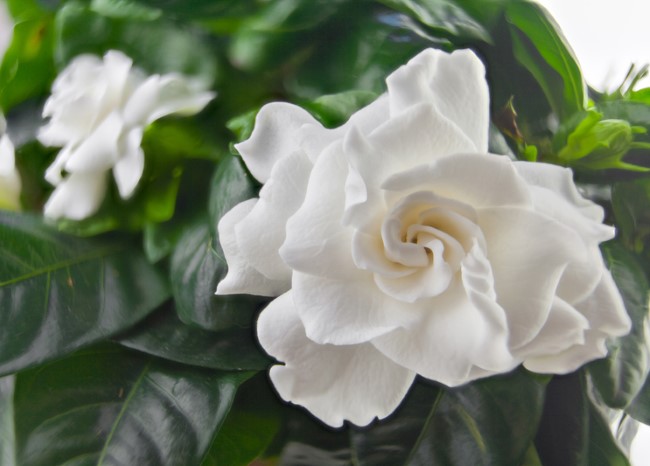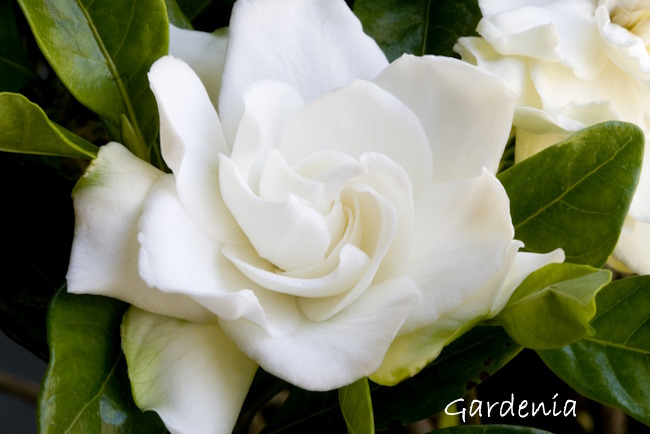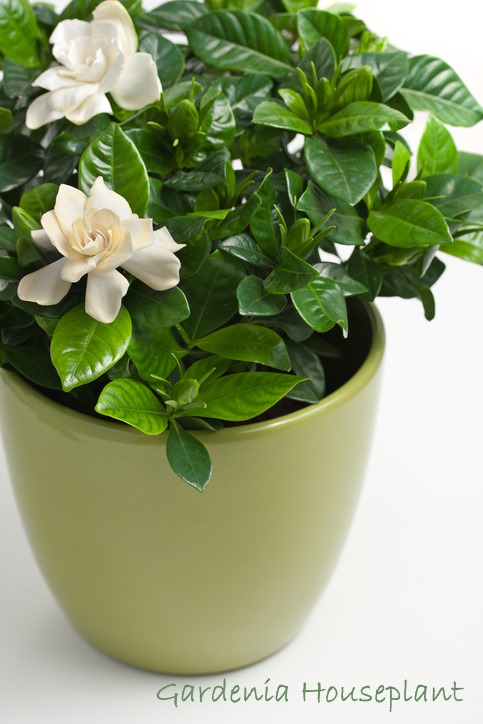Indoor Gardenia Care Tips
Botanical Name: Gardenia jasminoides
Good gardenia care will ensure long-lasting blooms and a long-lived flowering houseplant.
Here you'll discover the keys to success for growing gardenias indoors: what to do about flower bud drop, yellow leaves, pruning, plus how to get the most blooms.
 Beautifully fragrant flowers make Gardenia irresistible. Photo © Galina Nikolaeva
Beautifully fragrant flowers make Gardenia irresistible. Photo © Galina NikolaevaGardenia needs some attention year-round to thrive. But you won't mind. Gardenia's intoxicating fragrance and creamy white blossoms make it all worthwhile.
As soon as flower buds appear, step up your game and give it the perfect growing conditions. Find a good place for your gardenia in a well-lit area that's draft-free. Natural gas fumes will harm the plant, so growing gardenias near a gas stove or fireplace isn't a good idea.
Gardenias enjoy spending the summer outdoors. If you put it outside, keep it in a shady spot. Bring it back in if the temperature drops below 60°F. Happy plants may bloom a second time in the fall.
Gardenia Care Solutions and Special Helps
Dropped flower buds may be caused by a few things. Gardenia care includes plenty of bright light, regular watering, moderate temperatures and high humidity. In short, gardenias protest dark, dry, hot conditions.
Yellow leaves are a symptom of overwatering. Use a pot with drainage holes to prevent soggy soil. Are the leaves turning yellow, yet the leaf veins are still green? This acid-loving houseplant is nutritionally imbalanced. Feed your gardenia (see "Fertilizer" below). It also helps to keep it warm, year-round.
Shape it up. Pruning gardenia plants in late winter will keep them in good shape. Cut the stem at an angle, just above a node (the place where a leaf or branch is attached to the stem). Use sharp pruners to avoid tearing the stems.
Wondering when to repot? Repot in late winter, when you see roots growing through the drainage holes. You can control your houseplant's size by keeping it in a smallish container. In fact, gardenias are sometimes grown as bonsai plants.
Something bugging your plant? Watch for spider mites, which are attracted to houseplants in winter. These pests are so tiny, you'll first notice their fine webbing between stems and leaves. Isolate an infested plant and treat it right away with insecticidal soap. Spider mites like dry conditions; you can help to prevent an invasion by raising the humidity around your houseplants. Also keep an eye out for mealybugs and aphids. They may have hitched a ride indoors if your plant spent any time outside.
How to Get those Beautiful Blooms
- Cool nights (60°F) and warm days (75°F) will trigger flower buds.
- Gardenia flowers need plenty of light to bloom. Place your plant where it will get several hours of bright, filtered light each day.
- Flowering plants are thirsty. Check the soil at least every couple days. Dry soil will cause the buds to drop. Keep it moist but not soggy, which can also cause buds to drop.
 Photo istockphoto.com
Photo istockphoto.comBuying Tips
You'll find gardenia plants for sale in the spring and summer, when they're in bloom.
The most common gardenia for growing indoors is 'White Gem', a dwarf gardenia variety reaching only 2 ft (60 cm) tall. If you want a bonsai, gardenia 'Radicans' has an upright form, making it a favorite for shaping a gardenia tree.
Beautiful, little gardenia shrubs make welcome gifts. If you buy a gardenia for a loved one, be sure to treat yourself, too.
 Photo istockphoto.com
Photo istockphoto.comGardenia Care Tips
Origin: China
Height: 1-3 ft (30-90 cm)
Light: Bright indirect light. Some direct sunlight in winter is fine.
Water: Keep soil evenly moist during the growing season, slightly drier in winter. With gardenia yellow leaves are usually caused by overwatering. Use a pot with a drainage hole and allow soil to dry slightly between waterings.
Humidity: Gardenias love humidity. Try to maintain 60% relative humidity year-round. It's easier than you think. Use a cool-mist room humidifier or place the pot on a tray of wet pebbles. Misting is also a good idea in summer. With gardenia care should be taken to mist the foliage, and not the flowers.
Temperature: Normal room temperatures 60-75°F/16-24°C
Soil: Lime-free acidic potting mix, such as a peat-moss based mix.
Fertilizer: Feed gardenias during the growing season to keep them healthy and flowering. Use a fertilizer specially made for acid-loving plants. Feed every 2 weeks with a high-potassium fertilizer that contains iron, diluted by half. Only fertilize when watering to avoid fertilizer burn.
Propagation: Take 3-inch (8 cm) stem tip cuttings in spring or early summer. Dip cut ends in hormone rooting powder, then place in moist potting mix. Cover the plant with a cloche or a plastic bag to maintain humidity.


